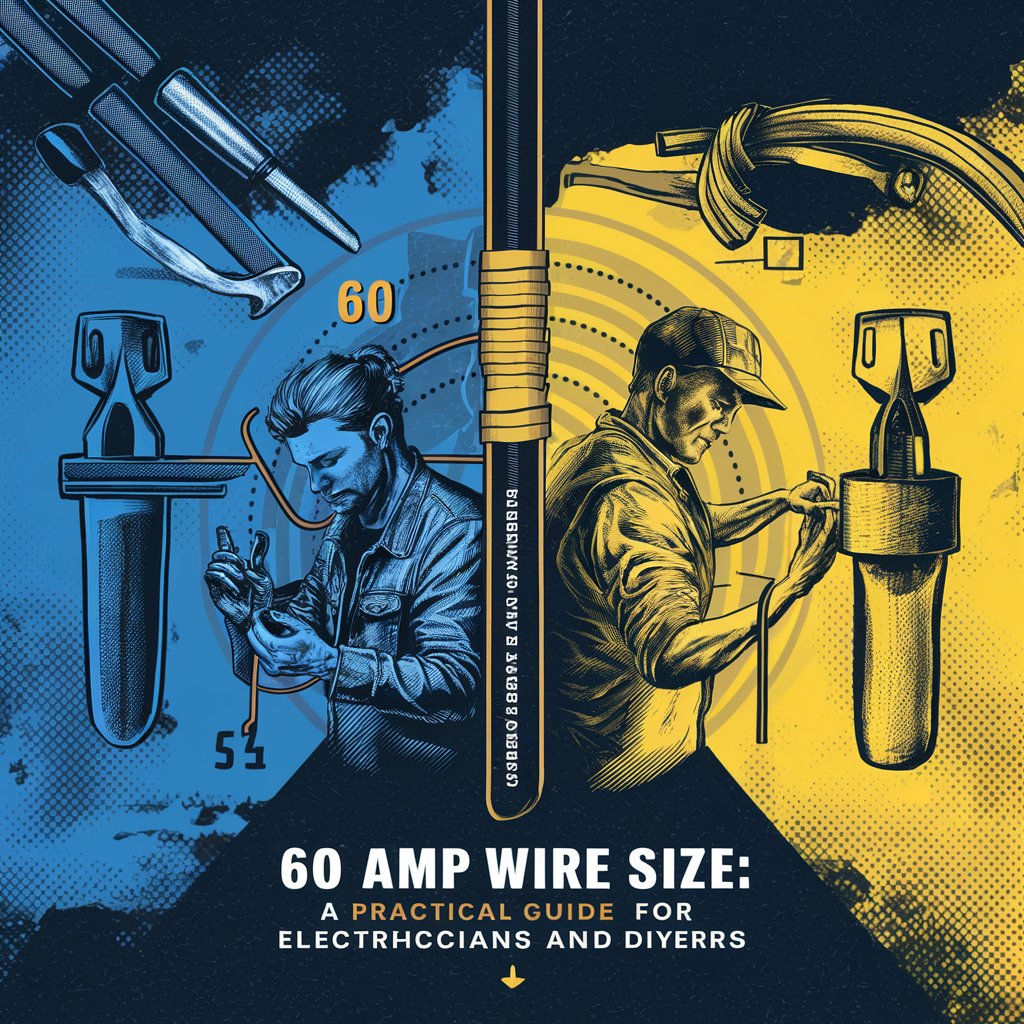More
60 Amp Wire Size: A Practical Guide for Electricians and DIYers

When it comes to electrical work, understanding wire size isn’t just a detail—it’s a critical aspect of safety and functionality. If you’re planning to set up or upgrade a circuit that requires 60 amps, knowing the right wire gauge can make all the difference. Choosing the correct wire size not only ensures your appliances run smoothly but also helps prevent dangerous overloads and potential fire hazards. Whether you’re an experienced electrician or a DIY enthusiast looking to tackle your next project, getting familiar with 60 Amp Wire Size is essential for both performance and peace of mind. Let’s dive into everything you need to know!
Understanding Electrical Load and Amperage
Understanding electrical load is crucial when working with circuits. It refers to the amount of power that devices consume while operating. Each appliance or tool has a specific voltage and current requirement, expressed in amps.
Amperage measures the flow of electric charge through a conductor. The higher the amperage, the more electricity flows. For example, a 60 Amp circuit can supply substantial energy for multiple appliances simultaneously.
Knowing your electrical load helps avoid overloading circuits. Overloaded wires can lead to overheating and potential fire hazards.
When planning installations or upgrades, always calculate total amperage requirements accurately. This ensures safety and efficiency in your home or workspace’s electrical system.
Keep in mind that different devices have varying loads based on their operation modes—starting versus running loads play significant roles too. Understanding these basics lays the groundwork for safe wiring practices and reliable performance.
Factors to Consider When Choosing Wire Size for a 60 Amp Circuit
When selecting the appropriate wire size for a 60 Amp circuit, several critical factors come into play.
First, consider the total electrical load you plan to support. Understanding your appliances and devices’ amp draw is essential. This ensures that your wiring can handle the demand without overheating.
Next, think about distance. The longer the run from your power source to your outlet or fixture, the thicker the wire needed to minimize voltage drop.
Temperature ratings also matter significantly. Wires rated for higher temperatures may allow smaller gauge wires in certain environments.
Additionally, local codes and regulations play an important role in determining wire size requirements. Always ensure compliance with these standards to maintain safety.
Environmental conditions such as moisture or exposure to chemicals can affect wire choice too. Adjusting for these variables will provide a more reliable electrical installation tailored to its surroundings.
The Different Types of Wires Used for 60 Amp Circuits
When working with 60 Amp circuits, choosing the right type of wire is crucial for performance and safety. Copper wires are often favored due to their excellent conductivity. They may be more expensive but tend to provide better efficiency.
Aluminum wiring is another option. It’s lighter and less costly than copper, making it attractive for some applications. However, aluminum requires careful handling because it can expand and contract significantly with temperature changes.
Another consideration is the insulation type. THHN (Thermoplastic High Heat-resistant Nylon-coated) wires are commonly used in dry locations and offer good heat resistance. For outdoor or damp environments, consider using UF (Underground Feeder) cables which have a solid moisture barrier.
Remember that each wire type has specific ampacity ratings to ensure safe electrical flow without overheating or risking fire hazards.
Step-by-Step Guide on How to Determine the Right Wire Size
To determine the right wire size for a 60 Amp circuit, start by identifying your total electrical load. Calculate the wattage of all devices you plan to run simultaneously. This will give you a clearer picture of how much current is needed.
Next, convert watts into amps using the formula: Amps = Watts / Volts. For example, if you’re working with a 240-volt system and have a total load of 4800 watts, you’ll need 20 amps.
Once you’ve established your amperage needs, refer to an ampacity chart. These charts list different wire sizes along with their corresponding amp ratings based on insulation type and temperature rating.
Consider additional factors like distance from the power source to your equipment. Longer distances may require larger wires due to voltage drop. It’s essential to account for these variables when making your final decision on wire size.
Safety Precautions When Working with Electrical Wiring
When working with electrical wiring, safety should always be your top priority. Start by turning off the power at the circuit breaker before touching any wires. This simple step can prevent serious accidents.
Always use insulated tools to minimize the risk of electric shock. Wearing rubber-soled shoes and keeping your workspace dry further enhances your safety.
It’s also essential to wear personal protective equipment (PPE), such as gloves and goggles, especially when dealing with exposed wires or heavy-duty circuits.
Be aware of your surroundings. Keep a clear area free from clutter and avoid distractions while you work. If you’re unsure about something, don’t hesitate to consult an expert or refer to local codes for guidance.
Make it a habit to double-check that all connections are secure before restoring power. Taking these precautions can save you from potential hazards while working on electrical projects.
Tips for Properly Installing and Maintaining 60 Amp Wiring
When installing 60 Amp wiring, start with a clear plan. Ensure you have all necessary tools and materials on hand to avoid interruptions.
Use the appropriate wire gauge for your specific setup. Copper is often preferred due to its excellent conductivity, but aluminum can be an alternative if weight is a concern.
Secure connections tightly to prevent overheating or arcing. Utilizing proper connectors and terminals will enhance reliability.
Regularly inspect your wiring system for signs of wear or damage. Look out for frayed insulation or loose connections which could pose hazards.
Keep the area around exposed wires clean and dry to minimize moisture-related issues. Consider using conduit where applicable for added protection against physical damage.
Document any changes made during installation or maintenance in case future reference is needed, ensuring safe practices remain consistent over time.
Common Mistakes to Avoid
Choosing the wrong wire size for a 60 Amp circuit is a frequent misstep. Many underestimate the importance of proper sizing, which can lead to overheating and system failure.
Another common mistake is neglecting distance in their calculations. The longer the run, the larger gauge wire needed to reduce voltage drop—this detail often gets overlooked.
Using unsuitable materials can also be problematic. Copper and aluminum have different properties, impacting safety and performance. Always ensure you’re using the correct type based on your specific requirements.
Ignoring local codes is an error that can come with serious consequences. It’s crucial to stay informed about regulations set by organizations like NEC to avoid penalties or unsafe installations.
Many rush through installation without double-checking connections and fittings. A thorough inspection helps prevent future electrical issues that could pose risks or require costly repairs down the line.
Wire Gauge Explained: AWG and its Relationship to Ampacity
Wire gauge is critical when discussing electrical wiring. The American Wire Gauge (AWG) system quantifies wire diameter, determining how much current a wire can safely carry. This measurement directly influences ampacity—the maximum amount of electric current a conductor can handle without overheating.
As the AWG number decreases, the wire diameter increases. For instance, a 4 AWG wire has a larger diameter than an 8 AWG wire. This difference means that thicker wires can support higher amperage levels without risk.
Understanding the relationship between AWG and ampacity helps electricians and DIYers choose appropriate wires for their projects. It ensures safety and efficiency in electrical systems by preventing potential hazards associated with overloading or overheating wires. When selecting your wiring, always refer to ampacity charts specific to materials like copper or aluminum for accurate guidance.
Voltage Drop: How it Affects Your Electrical System
Voltage drop occurs when electrical energy is lost as it travels along conductors. This reduction in voltage can lead to inefficiency and performance issues in your electrical system.
As current flows through wires, resistance generates heat, causing a decrease in voltage at the load end. If significant, this drop can impair equipment functionality or even cause devices to fail unexpectedly.
For a 60 Amp circuit, maintaining proper voltage is crucial for optimal operation. Excessive voltage drop may result in dim lights or motors failing to start efficiently.
To minimize these effects, selecting the right wire gauge becomes essential. Thicker wires reduce resistance and help maintain stable voltage levels across distances.
Monitoring your wiring setup not only enhances performance but also contributes to safety by preventing overheating and potential hazards associated with insufficient power delivery.
Safety Considerations: Overloading and Fire Hazards
When working with a 60 Amp circuit, understanding the risks of overloading is crucial. Overloading occurs when the circuit attempts to draw more current than it can safely handle. This can lead to overheating wires and components, which might ignite nearby materials.
Fire hazards are significant in electrical systems. If you exceed the ampacity ratings of your wiring, insulation may melt or burn away. This not only damages the wire but also creates a serious safety risk.
Always ensure that all devices connected to a 60 Amp circuit do not surpass its maximum load capacity. Regularly inspect connections for signs of wear or damage as well.
Using appropriate breakers is essential too. These protect against overloads by tripping when currents become excessive, preventing potential fires before they start. Remember that safety should always be your top priority when dealing with electricity.
Calculating Wire Size for 60 Amp Circuits
Calculating wire size for 60 Amp circuits involves several key factors. Start by determining the total load you plan to connect. This includes all devices that will draw power simultaneously.
Next, consider the distance between your panel and the load point. Longer distances can lead to voltage drop, which impacts performance. A general rule of thumb is to add a bit more capacity if you’re running wires over long stretches.
You’ll also need to refer to the American Wire Gauge (AWG) standards. For most applications at 60 amps, a minimum of six-gauge copper wire is typically recommended.
Keep in mind environmental factors such as temperature and insulation type too; they may require adjustments in your calculations. Always double-check local codes before finalizing your choices to ensure compliance with regulations specific to your area.
Factors Affecting Wire Size Selection: Distance, Load, and Temperature
When selecting the right wire size for a 60 Amp circuit, several factors come into play. Distance is crucial. The longer the run from the power source to the load, the more resistance and voltage drop you’ll encounter. This means you might need a thicker gauge wire than you’d expect.
Load is another significant consideration. Calculate your total amperage based on devices that will be running simultaneously. If you’re near or at capacity, using larger wires helps prevent overheating and ensures safety.
Temperature affects conductivity as well. Higher temperatures can lead to decreased ampacity of your wiring materials. Always consider ambient conditions when determining wire size for optimal performance and longevity in any installation scenario.
Common Applications for 60 Amp Wires
60 Amp wires are versatile and serve multiple applications in both residential and commercial environments. One common use is for large appliances, such as electric ranges, ovens, and dryers. These devices often demand significant power to operate efficiently.
Another frequent application is in workshops or garages where heavy-duty machinery like welders or air compressors may be utilized. These machines benefit from the robust capacity that a 60 Amp circuit provides.
Additionally, 60 Amp circuits are essential for outdoor installations, including hot tubs or spas. They ensure adequate power supply while maintaining safety standards.
In some cases, RV owners use 60 Amp wiring to connect their vehicles to shore power at campgrounds. This allows them to run various systems within the RV without worrying about overloading the electrical system.
Each of these applications showcases how integral proper wire sizing is for both performance and safety.
Code Requirements and Regulations: NEC and Local Codes
When dealing with 60 Amp wire size, understanding the National Electrical Code (NEC) is crucial. The NEC sets forth safety standards that help ensure proper installation and usage of electrical systems across the United States.
Local codes may add additional requirements or modifications to these national guidelines. Always check your local regulations before beginning any project. The interplay between NEC and local codes can affect everything from wire gauge to installation methods.
Failing to comply with these regulations could result in dangerous hazards or legal issues down the line. It’s essential for electricians and DIYers alike to stay updated on both NEC changes and local amendments.
Consulting a qualified electrician can be invaluable in navigating this landscape, ensuring that all work meets necessary compliance standards while maintaining safety as a top priority.
Troubleshooting Common Wire Sizing Issues
When working with 60 Amp wire size, issues can arise that disrupt your project. One common problem is choosing the wrong gauge. If you find frequent tripping of circuit breakers, this could indicate an undersized wire.
Another issue might be voltage drop. Long runs without proper sizing can lead to inefficiency and overheating. Always check the distance from the power source; it plays a significant role in selecting the right wire.
Improper connections are also a culprit for problems down the line. Loose or corroded terminals can cause arcing, leading to potential hazards.
If you notice flickering lights or appliances underperforming, reassess your ampacity calculations—these should align with local code requirements.
Staying vigilant about these factors helps maintain safety and efficiency in your electrical system.
Tools and Equipment for Working with 60 Amp Wires
Working with 60 Amp wires requires the right tools to ensure safety and efficiency. A quality wire gauge tool is essential for selecting the appropriate size. This device helps you avoid common mistakes in wire selection.
Strippers are another must-have. They make removing insulation from wire ends a breeze, allowing for clean connections without damaging the conductors inside.
Don’t forget about crimping tools. They are vital when working with terminals or connectors, ensuring solid electrical connections that can handle high amperage.
Safety gear should never be overlooked. Insulated gloves protect against unexpected shocks while goggles shield your eyes during cutting or stripping tasks.
A reliable multimeter is indispensable for checking voltage and continuity before making final connections. Having these tools on hand makes any project easier and safer.
Online Wire Size Calculators and Tools
Online wire size calculators are invaluable tools for electricians and DIY enthusiasts alike. They simplify the complex process of determining the appropriate wire gauge needed for various applications.
These calculators typically require input such as amperage, voltage, distance, and type of load. By entering these variables, users receive instant recommendations based on industry standards.
Using an online tool eliminates guesswork. It ensures that you choose a wire size that meets safety regulations while optimizing performance.
Many platforms also offer additional features like voltage drop calculations and ampacity charts. This can help you address specific project requirements effectively.
Additionally, some websites provide comprehensive guides alongside their calculators. These resources enhance your understanding of electrical systems and improve decision-making skills in wiring projects.
Recommended Reading and References
For those eager to dive deeper into the world of electrical wiring, a few valuable resources can enhance your understanding of 60 Amp wire size.
Books like “Electrical Wiring Residential” by Ray C. Mullin provide comprehensive coverage on residential wiring practices. This text is great for both beginners and experienced electricians alike.
Online platforms such as the National Electrical Code (NEC) website are crucial for staying updated on regulations and standards affecting wire sizing. These guidelines help ensure safety in all electrical installations.
Additionally, forums dedicated to DIY projects often share practical advice and firsthand experiences from fellow enthusiasts, making them rich sources of information.
Educational videos on platforms like YouTube offer hands-on demonstrations that can clarify complex concepts related to wire sizing and installation techniques.
Contacting a Qualified Electrician
When it comes to electrical work, the stakes are high. A mistake can lead to serious hazards like fire or electrocution. That’s why contacting a qualified electrician is crucial.
Whether you’re facing issues with your 60 Amp circuit or need advice on wire sizing, professionals have the expertise and tools for safe installations and repairs. They understand local codes and regulations that ensure compliance.
Additionally, electricians often offer warranty services for their work. This provides peace of mind knowing that if any problems arise later, they’ll handle them at no extra cost.
Finding a qualified electrician doesn’t just mean browsing online reviews; personal recommendations can be incredibly valuable too. Ask friends or family about trusted professionals in your area who’ve provided satisfactory results.
Always check credentials before hiring anyone. Look for licenses, insurance coverage, and relevant experience in handling projects similar to yours.
Conclusion
Choosing the right 60 Amp wire size is essential for safety and efficiency in any electrical project. Understanding your specific needs can make all the difference.
Electricians and DIY enthusiasts alike should be equipped with knowledge about amperage, voltage drop, and applicable codes. These factors ensure that installations run smoothly without compromising safety.
Always prioritize quality materials and adhere to regulations, as even small mistakes can lead to significant issues later on.
Whether you’re tackling a new circuit or upgrading an existing one, proper wire sizing is crucial for performance. Engaging with professionals when uncertain can save time and resources in the long run.
Stay informed through reliable sources to enhance your skills further. This journey into electrical wiring opens doors to many possibilities while ensuring you build safely within industry standards.
FAQs
What is the recommended wire gauge for a 60 Amp circuit?
For a 60 Amp circuit, the recommended wire size is typically #6 AWG copper or #4 AWG aluminum. This ensures safe and efficient electrical flow.
Can I use a smaller gauge wire for my 60 Amp circuit?
No, using a smaller gauge wire can lead to overheating and potentially cause fire hazards. It’s crucial to adhere to the appropriate sizing standards.
How far can I run a 60 Amp circuit without worrying about voltage drop?
The distance largely depends on your specific application. Generally, if you keep it under 100 feet, you should be fine; however, longer distances may require upsizing the wire.
What are common applications that require 60 Amp wiring?
You might find this level of amperage in electric vehicle chargers, subpanels in homes, and larger appliances like welders or hot tubs.
Are there any local codes I need to follow when installing 60 Amp circuits?
Yes! Always check your local electrical codes as they may have additional requirements beyond national guidelines set by the NEC (National Electrical Code).
Is it safe to work on electrical wiring myself?
While DIY projects can save money and provide satisfaction, it’s essential to know your limits. If you’re unsure about something related to wiring installation or repair tasks involving high ampacity circuits like these, contacting a qualified electrician is always wise.
Feel free to reach out if you have more questions regarding your project or need assistance choosing the right materials for optimal safety and performance.
More
Onion Play: A Comprehensive Guide to Free Streaming

In the ever-evolving world of online entertainment, Onion Play has emerged as a notable platform for streaming movies and TV shows without subscription fees. Offering a vast library of content across various genres, it caters to users seeking cost-free viewing experiences. However, as with many free streaming services, it’s essential to understand the platform’s features, legal implications, and potential risks.
Understanding Onion Play
Onion Play is a free online streaming website that provides access to a wide range of movies, TV shows, and documentaries. Users can stream content directly from their browsers without the need for registration or subscription fees. The platform aggregates links from various sources, allowing viewers to watch content in high-definition (HD) and even 4K quality, depending on their device and internet connection.
Key Features of Onion Play
1. Extensive Content Library
Onion Play boasts an extensive collection of over 200,000 movies and numerous TV series episodes. The content spans various genres, including action, drama, comedy, romance, horror, and more. Users can explore titles through categories like “Trending,” “New Releases,” and by genre, or use advanced filters for a more refined search experience.
2. High-Quality Streaming
The platform provides high-definition (HD) and 4K streaming options, ensuring an immersive viewing experience with vivid clarity and vibrant colors. Adaptive streaming technology adjusts video quality based on the user’s internet speed, minimizing buffering and interruptions.
3. User-Friendly Interface
Onion Play features a straightforward and intuitive interface, making it easy for users to navigate through categories and genres. The search functionality enables quick discovery of specific content, enhancing the overall user experience.
4. No Registration Required
One of Onion Play’s most attractive features is that users can stream content without creating an account or providing personal information. This allows viewers to access movies and TV shows immediately with just a click.
5. Multi-Device Compatibility
The platform is accessible on various devices, including desktops, laptops, smartphones, tablets, and smart TVs. This multi-platform availability ensures that users can enjoy content on their preferred devices, whether at home or on the go.
Legal and Safety Considerations
1. Copyright Issues
Onion Play operates in a legal gray area, as it provides access to copyrighted content without proper licensing. Streaming such content may violate copyright laws in many jurisdictions, potentially leading to legal consequences for users.
2. Security Risks
Free streaming sites like Onion Play often come with security risks, including malware and phishing attempts. Users may encounter pop-up ads, redirects, or malicious software that can compromise their devices and personal information. Employing ad blockers, antivirus software, and VPNs can mitigate some of these risks, but they do not eliminate the possibility of encountering malicious activities.
3. Mirror Sites and Impersonators
Due to frequent domain changes to avoid shutdowns, Onion Play has multiple mirror sites. These mirror or copycat sites typically don’t have links to the original Onion Play and are often hosted by unregulated third parties. Such sites may pose even greater security risks, including exposure to malware and data theft.
Comparing Onion Play to Legal Streaming Services
While Onion Play offers free access to a vast library of content, it’s essential to compare it with legal streaming services in terms of pricing, video quality, user experience, and legality.
1. Pricing
Onion Play is entirely free, making it appealing to users who want to access content without spending money. In contrast, legal streaming services like Netflix, Amazon Prime Video, Hulu, and Disney+ require monthly subscription fees, which vary depending on the plan and region.
2. Video Quality and User Experience
Legal streaming platforms provide consistently high video quality, including 4K resolution and HDR support on selected content. They also offer seamless user experiences with intuitive interfaces, personalized recommendations, and smooth playback. Onion Play, while offering HD and 4K options, may have inconsistent streaming experiences due to its free nature and potential server limitations.
3. Legality and Security
Legal streaming services operate with proper licenses and are committed to protecting user data with top-notch security protocols. Using platforms like Onion Play may expose users to legal risks and security threats, including malware and data breaches.
Tips for Safe Streaming
If you choose to use platforms like Onion Play, consider the following precautions to enhance your safety:
- Use a Reliable VPN: A Virtual Private Network can help protect your privacy by masking your IP address and encrypting your internet connection.
- Install Ad Blockers: Ad blockers can minimize exposure to intrusive ads and reduce the risk of encountering malicious content.
- Keep Antivirus Software Updated: Regularly updating your antivirus software can help detect and prevent malware infections.
- Avoid Clicking on Suspicious Ads: Be cautious of pop-up ads or redirects that may lead to harmful websites.
- Stay Informed About Legal Implications: Understand the copyright laws in your jurisdiction to avoid potential legal issues.
Conclusion
Onion Play offers a vast library of movies and TV shows for free, attracting users seeking cost-free entertainment. Its user-friendly interface, high-quality streaming options, and extensive content library make it a popular choice among viewers. However, the platform operates in a legal gray area and may pose security risks to users. While it provides an alternative to paid streaming services, it’s crucial to weigh the benefits against the potential legal and safety concerns. For a secure and lawful viewing experience, consider subscribing to licensed streaming platforms that ensure content creators are rightfully compensated.
More
Switching 2nd: A Strategic Move That Changes the Game

In many fields—sports, business, or even education—the phrase “Switching 2nd” carries a unique and powerful implication. Whether it’s changing positions in a team lineup or making a tactical adjustment mid-process, “Switching 2nd” reflects a moment when a secondary option becomes a primary strategy. Though the phrase may sound vague to the casual observer, it holds weight in competitive and decision-making contexts.
In this article, we will dive into the meaning of “Switching 2nd,” its usage across various domains, and why it has become a key phrase in strategic conversations. Transition words and real-life examples will guide you through each concept, making the term more understandable and relatable.
What Does “Switching 2nd” Mean?
At its core, “Switching 2nd” refers to changing a position, role, or plan that was originally second in order or importance. This switch can be voluntary, driven by strategy, or involuntary, resulting from necessity. In many scenarios, the second position is considered supportive, but when switched, it may take on a lead role.
This concept is not new. Historically, secondary options have become lifesavers when primary plans fail. What’s new is the popularity of the term across various disciplines, especially on social media, forums, and modern commentary.
Switching 2nd in Sports
Team Dynamics and Player Roles
In sports, Switching 2nd is often used to describe when a player changes from the second position to the first. For example, in baseball, a second baseman might move to shortstop due to injury or strategy. Likewise, in soccer, a striker might switch roles with a winger to outsmart the opposing defense.
Switching positions can be a game-changer. Although it may seem like a minor adjustment, it often results in improved performance, better coordination, or an unexpected advantage. Consequently, coaches and analysts frequently use this strategy to surprise the opposition.
Real-Life Example
Take the 2014 FIFA World Cup: Germany often rotated its players, “switching 2nd” attackers to midfield roles, confusing teams like Brazil. This strategic switch helped them dominate the tournament.
Switching 2nd in Business Strategy
Plan B Becomes Plan A
In the business world, Switching 2nd refers to moments when a backup plan becomes the new direction. This might happen when a company shifts from a primary product to a more successful secondary one.
Apple Inc. is a great example. Originally a computer company, its secondary product—the iPhone—quickly became its flagship. The company “switched 2nd” by prioritizing smartphones, and that move reshaped global tech forever.
Leadership and Organizational Change
Sometimes, a deputy or assistant manager rises to the top position unexpectedly. This is another form of Switching 2nd. Notably, companies often plan succession paths, ensuring the second-in-command is ready to take over if needed. This proactive planning enhances stability and shows the long-term value of “second” roles.
Switching 2nd in Education and Learning
In education, Switching 2nd can refer to students changing majors, shifting learning methods, or even switching to a second language as the main language of instruction. It might also involve moving from secondary schools to alternative educational institutions for better opportunities.
Example: Language Learning
A student may start learning French as a secondary language, but later switch it to their main language due to immigration or career needs. In this case, Switching 2nd becomes more than just academic—it shapes identity and opportunities.
Psychological Impact of Switching 2nd
Confidence and Flexibility
The act of switching from a second to a first position often requires a mindset of adaptability and courage. For some, the switch is empowering. It allows them to showcase hidden talents or operate more freely. For others, it may feel intimidating—taking the lead can bring pressure and responsibility.
However, those who embrace the change often emerge more confident, skilled, and appreciated. This transformation underscores the deeper emotional layers of “Switching 2nd.”
Pop Culture References
In film and television, characters often begin in secondary roles but emerge as heroes. Think of Samwise Gamgee in The Lord of the Rings—initially a supporting character, he eventually plays a pivotal role in Frodo’s journey. Similarly, in the Harry Potter series, characters like Neville Longbottom show how switching from the background to the spotlight can shape destiny.
These stories resonate because they reflect real human experiences. Everyone, at some point, has felt like they were second. Switching 2nd is a metaphor for stepping into your moment.
Challenges in Switching 2nd
While the phrase sounds empowering, it’s not without its hurdles:
- Role Confusion: Others may not recognize or respect the change.
- Expectations: The pressure to perform increases drastically.
- Time to Adjust: The transition from second to first isn’t always seamless.
Despite these challenges, those who adapt often achieve remarkable success.
Why “Switching 2nd” Matters Today
In today’s fast-changing world, flexibility is more valuable than ever. Whether it’s a business adjusting to market changes, an athlete adapting to a new position, or a student pivoting toward a new field, the ability to switch and succeed in a secondary role is essential.
Moreover, the digital world has democratized how people rise. Influencers, once considered “second” to celebrities, now lead major campaigns. Similarly, startup companies, once considered second-tier, are now redefining industries.
Conclusion: Embracing the Power of Second
In conclusion, Switching 2nd is more than a tactic—it’s a mindset. It teaches us that being second doesn’t mean being inferior. Often, second positions offer the best view of what needs to change. When the time is right, switching into that first spot can yield success, innovation, and transformation.
The next time you find yourself in the second spot, remember: you might just be in the perfect position to switch—and win.
More
Tonghou: Exploring the Meaning, Significance, and Cultural Impact

The term Tonghou may be unfamiliar to some, but it holds layered significance depending on the context in which it is used. From historical references to modern interpretations, Tonghou can relate to geography, culture, names, or institutions, particularly in East Asian contexts. Understanding what Tonghou means and where it appears can offer insight into both its cultural depth and practical relevance in today’s global landscape.
In this article, we explore the various meanings and uses of Tonghou, including its linguistic roots, geographic associations, potential cultural impact, and how it’s interpreted in different sectors.
What Is Tonghou?
The word Tonghou can serve multiple roles, depending on linguistic and regional context. In Chinese, “Tong” (通) often denotes communication, connectivity, or passage, while “Hou” (候) can mean to wait, expect, or refer to a noble rank. When combined, Tonghou might be interpreted as a proper noun, a place name, or a surname.
Alternatively, Tonghou could be transliterated from local dialects or used as a brand name, organization title, or institution, reflecting a mix of modern innovation and traditional influence. While there is no universally accepted definition, its usage reveals a pattern of importance in cultural, historical, and geographical contexts.
Historical and Geographical Relevance of Tonghou
1. Tonghou in East Asian Geography
In some regions, Tonghou refers to a specific location, such as a town, river, or administrative division. For example, Tonghou River or Tonghou Township may appear on maps in Taiwan or Mainland China, often associated with natural landmarks or historical trade routes.
These areas often bear the name due to their strategic importance — as transit routes or communication hubs — aligning with the meaning of “通” (passage or access). Such names typically reflect the region’s historical roles in commerce, governance, or military movements.
2. Tonghou as a Surname
Though less common, Tong–hou may also appear as a compound surname or given name in Chinese or Vietnamese culture. In these cases, the name could carry philosophical or aspirational meaning, often associated with virtues like patience, connectivity, or leadership.
Modern Usage and Cultural Significance of Tonghou
1. Tonghou as a Brand or Organization
In recent years, Tong-hou has also been adopted as a company or brand name across sectors such as technology, logistics, education, and manufacturing. The appeal lies in the characters’ positive connotations:
-
“Tong” (通): Implying connectivity, integration, and efficiency
-
“Hou” (候): Suggesting precision, strategy, and patience
Companies with names like Tong-hou Logistics or Tonghou Education Group may aim to project reliability, communication efficiency, and future-oriented thinking. This makes the name valuable in branding strategies focused on innovation and trustworthiness.
2. Tonghou in Philosophy and Literature
Some literary interpretations use Tong-hou to represent harmony between time (waiting or expecting) and action (communication or movement). In philosophical texts or poems, these dual meanings offer a metaphorical perspective on life balance, strategic thinking, or even political governance.
While rare in mainstream literature, niche publications, essays, and traditional poetry occasionally reference Tonghou as a symbolic idea — a balance of movement and stillness, readiness and response.
Tonghou and Digital Presence
1. Domain Names and Online Identity
With globalization and digital branding, unique terms like Tong-hou have become desirable for domain names and online platforms. Businesses, artists, and content creators may register tonghou.com or similar domains to establish a distinct digital identity.
The uniqueness of the name allows for stronger search engine visibility and easier brand recognition. In an internet space saturated with generic names, “Tonghou” offers linguistic distinctiveness and cultural nuance.
2. Social Media and Content Creation
Creators in fields like education, traditional arts, or Chinese history may adopt Tong-hou as a social media handle or brand name. It can symbolize a connection between the past and the present — a nod to cultural roots while engaging with modern audiences.
Interpreting Tonghou Through Language
1. Linguistic Variations
Depending on tonal pronunciation and character selection, Tong-hou can take on different meanings in Mandarin or Cantonese. For example:
-
通候 (Tōnghòu): Could imply “waiting for communication” or “channel of waiting”
-
同厚 (Tónghòu): May refer to “equal generosity” or “shared kindness”
Understanding these variations is important for interpreting the term in cultural, poetic, or business contexts.
2. Cross-Cultural Influence
As more East Asian words and concepts enter the global lexicon, names like Tong-hou may be embraced internationally. They offer a blend of tradition and versatility, which appeals to multicultural businesses or art communities seeking symbolic resonance.
Ethical and Cultural Considerations
Using or referencing Tonghou in content, branding, or public discourse comes with a responsibility to understand its cultural implications. Misuse or superficial adoption without respect for its roots can lead to misrepresentation or cultural dilution.
When naming a company or project Tong-hou, it is respectful to research the origin, consult native speakers, or understand how it may be perceived by different cultural audiences.
Conclusion
Tonghou is a multifaceted term with deep linguistic, geographical, and cultural layers. Whether seen as a place name, a personal name, or a brand identity, it reflects core values like communication, patience, and connectivity. In both historical and modern contexts, Tong-hou remains relevant and thought-provoking.
As globalization continues to bring diverse terms into wider usage, understanding concepts like Tong-hou becomes essential. It’s more than just a name — it’s a reflection of cultural identity, philosophical thinking, and modern branding potential.
-

 Entertainment1 year ago
Entertainment1 year agoYoungTube 101: Tapping the Youthful Side of Online Video
-

 Pet2 years ago
Pet2 years agoDog Training Tips: Throw me a bone, will you?
-

 Entertainment2 years ago
Entertainment2 years ago4 Reasons Why She Doesn’t Call You Back
-

 Fitness1 year ago
Fitness1 year agoThe Allure of Sports T-Shirts: A Blend of Style and Team Spirit:
-

 Fitness2 years ago
Fitness2 years agoTotal Mind and Body Fitness Blog Carnival 165
-

 Fitness2 years ago
Fitness2 years agoTotal Mind and Body Fitness Blog Carnival 141
-

 Health2 years ago
Health2 years agoWhat Is Healthy?
-

 Pet1 year ago
Pet1 year agoPet Supplies Plus: A Complete Guide to Pet Health
